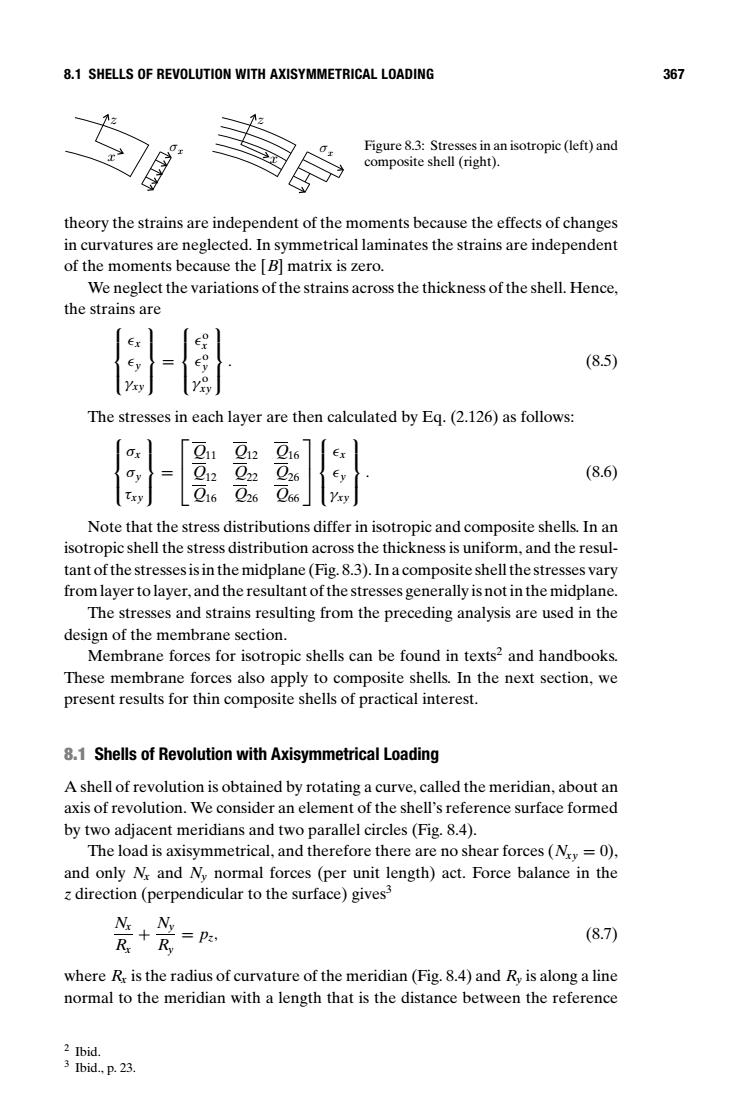正在加载图片...

8.1 SHELLS OF REVOLUTION WITH AXISYMMETRICAL LOADING 367 Figure 8.3:Stresses in an isotropic(left)and composite shell(right). theory the strains are independent of the moments because the effects of changes in curvatures are neglected.In symmetrical laminates the strains are independent of the moments because the B]matrix is zero. We neglect the variations of the strains across the thickness of the shell.Hence, the strains are (8.5) The stresses in each layer are then calculated by Eq.(2.126)as follows: Ox Q11 Q12 12 Q22 (8.6) 16 26 066 Note that the stress distributions differ in isotropic and composite shells.In an isotropic shell the stress distribution across the thickness is uniform,and the resul- tant of the stresses is in the midplane(Fig.8.3).In a composite shell the stresses vary from layer to layer,and the resultant of the stresses generally is not in the midplane. The stresses and strains resulting from the preceding analysis are used in the design of the membrane section. Membrane forces for isotropic shells can be found in texts2 and handbooks. These membrane forces also apply to composite shells.In the next section,we present results for thin composite shells of practical interest 8.1 Shells of Revolution with Axisymmetrical Loading A shell of revolution is obtained by rotating a curve,called the meridian,about an axis of revolution.We consider an element of the shell's reference surface formed by two adjacent meridians and two parallel circles(Fig.8.4). The load is axisymmetrical,and therefore there are no shear forces (My=0), and only Mr and Ny normal forces (per unit length)act.Force balance in the zdirection(perpendicular to the surface)gives3 N:Ny +R, =Pz (8.7) where Rr is the radius of curvature of the meridian(Fig.8.4)and Ry is along a line normal to the meridian with a length that is the distance between the reference 2 Ibid. 3 Ibid..p.23.8.1 SHELLS OF REVOLUTION WITH AXISYMMETRICAL LOADING 367 z x σx z x σx Figure 8.3: Stresses in an isotropic (left) and composite shell (right). theory the strains are independent of the moments because the effects of changes in curvatures are neglected. In symmetrical laminates the strains are independent of the moments because the [B] matrix is zero. We neglect the variations of the strains across the thickness of the shell. Hence, the strains are x y γxy = o x o y γ o xy . (8.5) The stresses in each layer are then calculated by Eq. (2.126) as follows: σx σy τxy = Q11 Q12 Q16 Q12 Q22 Q26 Q16 Q26 Q66 x y γxy . (8.6) Note that the stress distributions differ in isotropic and composite shells. In an isotropic shell the stress distribution across the thickness is uniform, and the resultant of the stresses is in the midplane (Fig. 8.3). In a composite shell the stresses vary from layer to layer, and the resultant of the stresses generally is not in the midplane. The stresses and strains resulting from the preceding analysis are used in the design of the membrane section. Membrane forces for isotropic shells can be found in texts2 and handbooks. These membrane forces also apply to composite shells. In the next section, we present results for thin composite shells of practical interest. 8.1 Shells of Revolution with Axisymmetrical Loading A shell of revolution is obtained by rotating a curve, called the meridian, about an axis of revolution. We consider an element of the shell’s reference surface formed by two adjacent meridians and two parallel circles (Fig. 8.4). The load is axisymmetrical, and therefore there are no shear forces (Nxy = 0), and only Nx and Ny normal forces (per unit length) act. Force balance in the z direction (perpendicular to the surface) gives3 Nx Rx + Ny Ry = pz, (8.7) where Rx is the radius of curvature of the meridian (Fig. 8.4) and Ry is along a line normal to the meridian with a length that is the distance between the reference 2 Ibid. 3 Ibid., p. 23